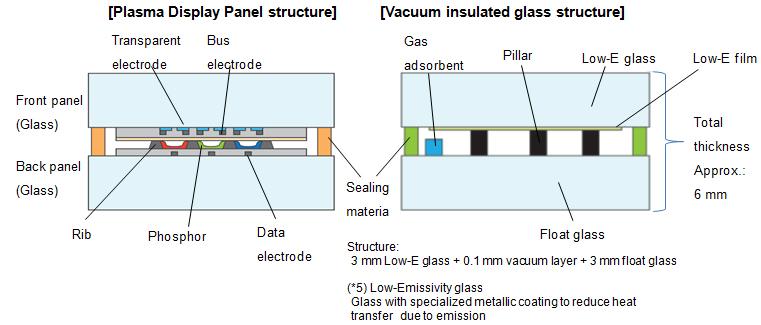
Mar 06, 2024
- Products & Solutions
- Press Release
- Asia and Oceania
- Business Solution
- Home & Personal Solution
- Air Conditioning
Dec 05, 2017
Products & Solutions / Press Release
The new vacuum insulated glass achieves the industry's top-class(*1) insulation performance for glass of approx. 6 mm total thickness
![[Vacuum insulated glass],[Vacuum insulated glass (close-up)],[Hussmann Corporation product usage concept]](/global/press/data/2017/12/en171205-2/en171205-2-1.jpg)
Osaka, Japan - Panasonic Corporation today announced it has developed and succeeded in mass production of thin, high-performance vacuum insulated glass by applying technologies the company accumulated in the development and manufacturing of plasma display panels (PDPs). The glass achieves a heat transfer coefficient (Ug value) of 0.7 (W/m²K)(*2), the industry's top-class(*1) insulation performance for glass with a total thickness of 6 mm, which is equal to or greater than triple glass containing argon gas(*3) with a total thickness of about 3 cm.
A PDP displays an image by causing phosphors to emit light within an extremely thin vacuum layer between two sheets of glass that are vacuum-sealed. Generally, to maintain the vacuum state within the glass, vacuum sealing material technology is required to suppress emission of gas from the substances inside the vacuum layer while maintaining a high vacuum state. Panasonic has retained the vacuum glass panel manufacturing technology and lead-free vacuum maintaining material technology that it cultivated during the development and manufacture of PDPs.
Now, Panasonic has realized a practical vacuum insulated glass with excellent insulation performance by developing a new slim-model gas adsorbent that adsorbs the gas that occurs within the vacuum layer, and a new low thermal conductive component that forms a 0.1 mm gap between the two sheets of glass. Due to the unique manufacturing method the company developed, the exhaust hole sealing component required to form the vacuum space is not present on glass surface, which gives a smooth, flat product appearance. Furthermore, this product uses no lead, a hazardous substance, ensuring safety and environmental friendliness.
This new vacuum insulated glass will be first used by Hussmann Corporation, the U.S. refrigerator and freezer showcase manufacturer wholly-owned by Panasonic, prior to commercialization. Hussmann will use the glass for automatic glass door systems for walk-in coolers and freezers in convenience stores and supermarkets to address tightened regulations by the United States Department of Energy(*4).
Panasonic plans to offer the glass as part of its insulation solutions in Japan and overseas to respond to the global trend toward stricter emission regulations, as seen in the Paris Accord, and help achieve a sustainable society.
A PDP displays an image by causing phosphors to emit light within an extremely thin vacuum layer between two sheets of glass that are vacuum-sealed. Panasonic utilized its accumulated PDP development and manufacturing technology to develop a unique slim-model vacuum insulated glass with a total thickness of approximately 6 mm, featuring insulation performance equivalent to triple argon-containing glass (total thickness approximately 3 cm).

In this exclusive new vacuum insulated glass manufacturing method developed by Panasonic, the exhaust hole sealing structure required to form a vacuum space between the two glass panes is not present on glass surface, which achieves a smooth, flat product appearance. This not only contributes to visual design, but also superior workability and ease of assembly with other components.
The vacuum sealing material used by Panasonic in its PDPs achieved advanced vacuum maintenance and durability without using lead. The vacuum insulated glass also utilizes this vacuum sealing material to achieve lead-free status. That will give users peace of mind regarding safety and environmental friendliness throughout product lifetime for both household and commercial purposes.
The United States Department of Energy regulations enacted on March 27, 2017 (DOE2017) require a significant reduction in energy allowance of display cases. Hussmann Corporation, a refrigerator and freezer showcase manufacturer, has become an early adopter of this vacuum insulated glass for their STYLELINE ABC DOOR, an indoor automatic door for convenience stores and supermarkets. The glass allows compliance with the DOE2017 standard.
(URL: http://www.styleline.com/)
Panasonic Corporation is a worldwide leader in the development of diverse electronics technologies and solutions for customers in the consumer electronics, housing, automotive, and B2B businesses. Celebrating its 100th anniversary in 2018, the company has expanded globally and now operates 495 subsidiaries and 91 associated companies worldwide, recording consolidated net sales of 7.343 trillion yen for the year ended March 31, 2017. Committed to pursuing new value through innovation across divisional lines, the company uses its technologies to create a better life and a better world for its customers. To learn more about Panasonic:
http://www.panasonic.com/global
Panasonic Corporation
Tel: +81-(0)3-3574-5664
The content in this website is accurate at the time of publication but may be subject to change without notice.
Please note therefore that these documents may not always contain the most up-to-date information.
Please note that German, French and Chinese versions are machine translations, so the quality and accuracy may vary.